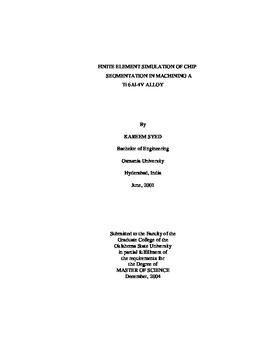| dc.contributor.author | Syed, Kareem | |
| dc.date.accessioned | 2014-04-17T19:54:13Z | |
| dc.date.available | 2014-04-17T19:54:13Z | |
| dc.date.issued | 2004-12-01 | |
| dc.identifier.uri | https://hdl.handle.net/11244/10073 | |
| dc.description.abstract | Ti 6Al-4V, a titanium alloy introduced in 1954, is considered the workhorse amongst the titanium alloys and is available in all product forms. It is extensively used in aerospace industry because of its excellent strength-to-weight ratio maintained at elevated temperatures, fracture resistance characteristics and exceptional corrosion resistance. The machinability of this alloy is generally considered to be poor owing to its several inherent properties. It is very reactive chemically and therefore has a tendency to weld to the cutting tool during machining. Its low thermal conductivity increases the temperature at the tool/workpiece interface, which affects the tool life adversely. Additionally, its high strength maintained at elevated temperature, low modulus of elasticity further impairs its machinability. In order to overcome the machinability issues associated with machining Ti 6Al-4V, an attempt has been made in this study to observe the effect of machining conditions on the chip formation, rake face and shear zone temperatures and cutting forces. To simulate orthogonal metal cutting of Ti 6Al-4V a commercial, general-purpose FE code (AdvantEdge) has been used. AdvantEdge has the facility to incorporate user-defined material subroutine (UMAT). Using this, Johnson-Cook material model and Recht's catastrophic shear failure criterion are incorporated into the UMAT subroutine code. Finite element simulations are conducted for a range of cutting speeds from 10 m/min to 100 m/min using two different depths of cut of 0.25 and 0.5 mm, for different rake angles from -15 to 45 using depth of cut of 0.5 mm and cutting speed of 30 m/min and for different values of coefficient of friction ranging from 0.3 to 0.9 using depth of cut of 0.5 mm and cutting speed of 30 m/min. Results of the simulations are compared with the experimental data and are found to be in close agreement. Mechanism of chip formation studied from simulations closely matched with that proposed in the literature. Effect of cutting speed, depth of cut, rake angles and coefficient of friction on cutting forces, temperature, strains and chip morphology is studied. Finally, cutting speed for the onset on chip segmentation is found for two different depths of cut. | |
| dc.format | application/pdf | |
| dc.language | en_US | |
| dc.publisher | Oklahoma State University | |
| dc.rights | Copyright is held by the author who has granted the Oklahoma State University Library the non-exclusive right to share this material in its institutional repository. Contact Digital Library Services at lib-dls@okstate.edu or 405-744-9161 for the permission policy on the use, reproduction or distribution of this material. | |
| dc.title | Finite Element Simulation of Chip Segmentation in Machining a Ti 6al-4v Alloy | |
| dc.type | text | |
| osu.filename | Syed_okstate_0664M_1107.pdf | |
| osu.college | Engineering, Architecture, and Technology | |
| osu.accesstype | Open Access | |
| dc.description.department | Mechanical & Aerospace Engineering | |
| dc.type.genre | Thesis | |
| dc.subject.keywords | ti6al4v | |
| dc.subject.keywords | shear-localized chip | |
| dc.subject.keywords | orthogonal cutting | |
| dc.subject.keywords | metal cutting | |
| dc.subject.keywords | segmented chip | |
| dc.subject.keywords | aerospace alloys | |
